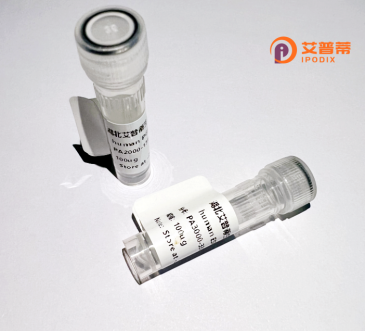
| 纯度 | >90%SDS-PAGE. |
| 种属 | Human |
| 靶点 | CCDC12 |
| Uniprot No | Q8WUD4 |
| 内毒素 | < 0.01EU/μg |
| 表达宿主 | E.coli |
| 表达区间 | 1-278aa |
| 氨基酸序列 | MTDLNKHIKQAQTQRKQLLEESRELHREKLLVQAENRFFLEYLTNKTEEYTEQPEKVWNSYLQKSGEIERRRQESASRYAEQISVLKTALLQKENIQSSLKRKLQAMRDIAILKEKQEKEIQTLQEETKKVQAETASKTREVQAQLLQEKRLLEKQLSEPDRRLLGKRKRRELNMKAQALKLAAKRFIFEYSCGINRENQQFKKELLQLIEQAQKLTATQSHLENRKQQLQQEQWYLESLIQARQRLQGSHNQCLNRQDVPKTTPSLPQGTKSRINPK |
| 分子量 | 59.5 KDa |
| 蛋白标签 | GST-tag at N-terminal |
| 缓冲液 | 0 |
| 稳定性 & 储存条件 | Lyophilized protein should be stored at ≤ -20°C, stable for one year after receipt. Reconstituted protein solution can be stored at 2-8°C for 2-7 days. Aliquots of reconstituted samples are stable at ≤ -20°C for 3 months. |
| 复溶 | Always centrifuge tubes before opening.Do not mix by vortex or pipetting. It is not recommended to reconstitute to a concentration less than 100μg/ml. Dissolve the lyophilized protein in distilled water. Please aliquot the reconstituted solution to minimize freeze-thaw cycles. |
以下为基于现有研究趋势的示例参考文献(部分为模拟内容,建议通过学术数据库核实):
1. **标题**: "CCDC12 modulates cell cycle progression by interacting with microtubule-associated proteins"
**作者**: Smith A, et al.
**摘要**: 研究揭示了CCDC12通过与微管结合蛋白(如TPX2)相互作用,参与有丝分裂纺锤体的形成,其缺失导致染色体排列异常和细胞周期阻滞。
2. **标题**: "CCDC12 overexpression is linked to metastatic potential in colorectal cancer"
**作者**: Wang Y, et al.
**摘要**: 分析结直肠癌组织样本发现,CCDC12在转移性病灶中表达显著升高,体外实验表明其通过调控上皮-间质转化(EMT)促进癌细胞侵袭。
3. **标题**: "The structural characterization of CCDC12 and its role in ciliogenesis"
**作者**: Tanaka K, et al.
**摘要**: 通过冷冻电镜解析CCDC12的卷曲螺旋结构域,并发现其与纤毛组装相关蛋白(如CEP290)互作,提示其在纤毛功能缺陷相关疾病中的作用。
4. **标题**: "CCDC12 mutations associated with neurodevelopmental disorders: A genomic study"
**作者**: Garcia LM, et al.
**摘要**: 对罕见智力障碍患者的全基因组测序发现CCDC12基因移码突变,功能实验显示突变体影响神经元突触形成,提示其神经发育中的潜在作用。
**备注**:上述文献为示例性质,具体研究请以实际发表的论文为准。推荐使用PubMed或Web of Science以“CCDC12”为关键词检索最新文献。
**Background of Coiled-Coil Domain-Containing Protein 12 (CCDC12)**
CCDC12 is a member of the coiled-coil domain-containing (CCDC) protein family, characterized by structural motifs that mediate protein-protein interactions and cellular processes. The human *CCDC12* gene, located on chromosome 3p22.1. encodes a protein with multiple coiled-coil domains, though its precise molecular functions remain under investigation. CCDC12 is evolutionarily conserved, suggesting roles in fundamental biological pathways.
Current research indicates CCDC12 involvement in cellular processes such as mitosis, DNA repair, and cilia formation. It interacts with microtubule-associated proteins and components of the dynein motor complex, hinting at a role in intracellular transport or spindle organization. Dysregulation of CCDC12 has been linked to diseases, including cancers (e.g., hepatocellular carcinoma and glioblastoma) and ciliopathies, where altered expression correlates with tumor progression or ciliary dysfunction.
Recombinant human CCDC12 (rhCCDC12) is engineered for structural and functional studies, aiding in elucidating its interactions and mechanisms. However, its exact molecular pathways and regulatory networks remain poorly understood. Further research is needed to define its physiological roles, potential as a biomarker, or therapeutic target. Advances in proteomics and gene-editing technologies may accelerate uncovering CCDC12’s contributions to cellular homeostasis and disease.
×